Frontiers of Far-Ultraviolet Spectroscopy in the Solid and Liquid States
Spectroscopy
This article reviews the state-of-the-art of far-ultraviolet (FUV) spectroscopy of solid and liquid phases. FUV spectroscopy is rich in information about electronic structure and transitions of a molecule, but this region has been employed to investigate mainly for the electronic states and structure of gas molecules because the absorptivity is very high in the FUV region. To overcome this difficulty we have developed a totally new FUV spectrometer based on the attenuated total reflection (ATR) technique. ATR-FUV spectroscopy has paved a new avenue for condensed matter FUV spectroscopy. This article demonstrates that FUV holds considerable promise not only in basic science such as studies of electronic structure of molecules, hydrogen bonding, hydration, and adsorption of water and aqueous solutions, but also practical applications, such as on-line analysis, geochemical and environmental analyis, semiconductor research and surface analysis.
This article reviews the state of the art of far-ultraviolet (FUV) spectroscopy of solid and liquid phases. FUV spectroscopy is rich in information about electronic structure and transitions of a molecule, but this region is useful mostly for investigating the electronic states and structure of gas molecules because absorptivity is very high in the FUV region. To overcome the difficulty of high absorptivity we have developed an FUV spectrometer based on the attenuated total reflection (ATR) technique. ATR-FUV spectroscopy has paved a new avenue for condensed-matter FUV spectroscopy. This article demonstrates that FUV spectroscopy holds considerable promise not only in basic science such as for studies of the electronic structure of molecules, hydrogen bonding, hydration, and adsorption of water and aqueous solutions, but also for practical applications such as on-line analysis, geochemical and environmental analyis, semiconductor research, and surface analysis.
Recently, the ultraviolet (UV) region shorter than 300 nm has received keen interest because of rapid development of instruments and the increase in the possible applications(1–5). The 10–300 nm UV region in the may be devided into three regions: extreme UV (EUV), far UV (FUV), and deep UV (3). Each region has specific features and a very promising future. In this article we outline the state-of-the art of FUV spectroscopy (wavelength region: 120−200 nm) of liquids and solids, which is concerned with various valence electronic transitions including σ, n, and p electrons (3–25). Spectra in the FUV region have been investigated for molecules in the gas phase for more than 50 years (3,26–29). FUV spectroscopy studies of the gas phase have revealed that various kinds of molecules have strong absorptions caused by electronic transitions to low-lying Rydberg states in the FUV region until their vertical ionized energy. FUV spectra of liquid and solid samples also have been studied for more than 40 years, although this research has been very limited (3). Rudloff and colleagues (30) and Jung and Gress (31) employed synchrotron radiation to observe transmission FUV spectra of simple solid and liquid molecules. Other groups have used extremely thin water films (2850 Å thick) to measure FUV spectra of water (32,33). Reï¬ection spectra in the FUV region of water were also reported (34,35).
The development of FUV spectroscopy of solid and liquid molecules has been greatly delayed because of three major reasons (2–5). One is that the solid and liquid samples show very intense absorption in the FUV region. Another reason is that one had to evacuate an instrument to avoid strong absorption of oxygen. The third reason, is that it was difficult to find practical applications in the FUV region. However, the introduction of attenuated total reflection (ATR) spectroscopy to the 140–200 nm region has changed the situation dramatically(8). Currently, one can measure FUV spectra of any kind of solid and liquid material by using ATR-FUV spectroscopy under nitrogen gas purge.
Characteristics and Advantages of FUV Spectroscopy of Condensed Materials
Many materials that do not show a signiï¬cant absorption in the region longer than about 200 nm yield intense absorptions in the FUV region. Spectra in this region also contain the transitions between electronic energy levels including Rydberg states. Band assignments in the FUV region are not straightforward and have not been well established. Recently, quantum chemical calculations have been extensively applied to band assignments (13,15,16).
Another characteristic of FUV spectroscopy is that oxygen exhibits a very intense absorption, and thus a spectrometer used in this region must be evacuated or purged with nitrogen gas.
FUV spectroscopy yields rich information about the electronic transitions and structure of a molecule. Unique information can be obtained that cannot be obtained from ordinary UV spectroscopy. For example, one can investigate Rydberg transitions of liquids and solids (10,13,15,16). The first electronic transition

of water was assigned to the excitation of nonbonding electrons on the oxygen atom (1b1) to the 4a1 orbital involving the σ* orbital and the 3s Rydberg orbital (10). It is also possible to explore π–π* transitions of small molecules by using FUV spectroscopy (16). Another advantage of FUV spectroscopy is that one can apply it to investigate hydrogen bonding and hydration of water, aqueous solutions, and organic molecules (2–5). Moreover, FUV spectroscopy can be applied to qualitative analysis and discrimination analysis of various liquid and solid samples because each molecule shows a unique FUV spectrum (2–5). FUV spectroscopy is also powerful for highly sensitive quantitative analysis because almost all molecules yield strong absorption in the FUV region, and the intensity and wavelength of an FUV band are very sensitive to changes in concentration, temperature, and pH (2–5).
Recent developments in FUV spectroscopy include the development of FUV spectrometers (3,8,19), studies of electronic structure and transitions in organic and inorganic molecules and polymers (10–13, 15,16), and a variety of applications, such as those to water and aqueous solution analyses (10,17,18,20), industrial process analysis (7,20), polymer thin film analysis (9), electronic states and photocatalytic activity of TiO2 (21–23,25), and surface plasmon resonance (SPR) in the FUV region.
Development of New Types of FUV Spectrometers for Condensed Materials
Recently, two new FUV spectrometers have been developed, each with different operating principles. The first one is the compact FUV spectrometer shown in Figure 1 (7). It enables one to obtain spectra of liquid samples down to 180 nm with nitrogen gas purge. Its dimensions are 30 cm × 16 cm × 16 cm, and it includes a UV light source, a grating, a photo absorption cell, and an optical sensor. The FUV light source used was a deuterium lamp with a transparent window made of MgF2 in the 180–220 nm region. The pitch of the grating mirror was 2400/mm, and the blazed wavelength was 250 nm. The optical pathlength of the sample cell employed was 0.5 mm. Since this spectrometer was designed for direct determination of industrial components in aqueous solutions in an on-line monitoring situation, much attention was paid to detect enough brightness in preference to the resolution of detectable wavelength (7). A thin diamond film sensor was used as an optical sensor in the FUV spectrometer because of the bright FUV radiation. The spectrometer requires only 0.1 L/min of N2 gas blown into the measuring area. One good example for the use of this instrument will be reported later.
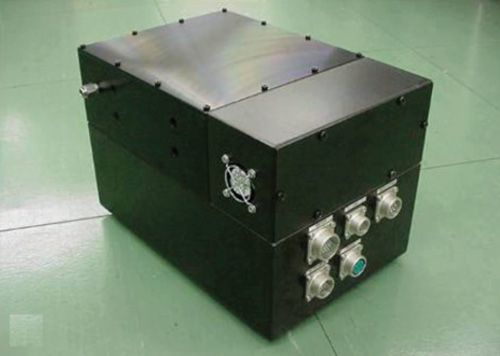
Figure 1: The compact FUV spectrometer.
A second new spectrometer is an ATR-FUV instrument that covers the 140–300 nm wavelength region (8). This spectrometer employs the evanescent wave created through total reflection when light is passed through an internal reflection element in contact with a sample. By using this instrument one can detect the ent first electronic transition absorption band of water down to 140 nm. The details of the instrument were described in reference 8. In this article we will show a few examples that have been carried out by using this instrument.
We also developed a time-resolved ATR-FUV spectrometer for the investigation of radical species in a chain reaction to measure transient absorption spectra for stable and radical species in the 170–185 nm region (19).
Examples of FUV Spectra of Solids and Liquids
Water
Figure 2 shows temperature-dependent ATR-FUV spectra of light and heavy water in the 140–220 nm (9–6 eV) region measured over a temperature range of 10–70 °C by the ATR-FUV instrument (10). Note that the whole first electronic transition band of water can be observed. It is also interesting to note that the peak of D2O lies at higher energy than that of H2O. This shift is attributed to the difference in vibrational zero-point energy.
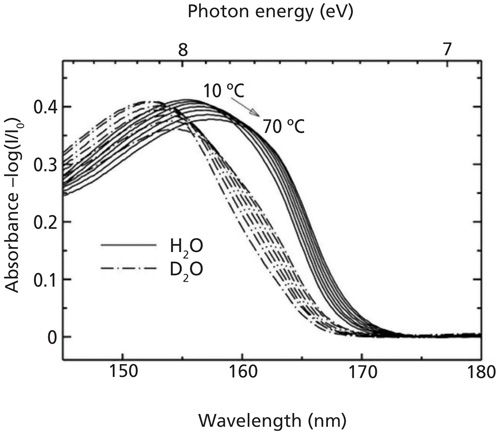
Figure 2: ATR-FUV spectra of H2O and D2O at different temperatures. (Adapted with permission from reference 10.)
The origin of the low-lying electronic transition band of water, Ã←X~, was not conclusively established. The Ã←X~ transition of water is very susceptible to its hydrogen bonding and hydration state, because the nonbonding electrons on the oxygen atom interact electronically with electron acceptors: hydrogens of the other water and cations (10). The Ã←X~ transition energy of water increases because the hydrogen bond interaction is strong: 7.4 eV (vapor), 8.3 eV (liquid), and 8.7 eV (solid). That of liquid water increases from 8.26 eV to 8.40 eV as the temperature decreases from 70 °C to 10 °C.
Figure 2 shows solid evidence for the redshift of the first absorption band of liquid water upon heating. Ikehata and colleagues (12), as well as Goto and colleagues (18) explored effects of cations on the transition of liquid water. By using time-resolved FUV spectroscopy, pulse laser photolysis of aqueous ozone was carried out (20). Another interesting application example is the qualitative and quantitative analyses of spring water samples by FUV–deep UV (DUV) spectroscopy (14).
Goto and colleagues (24) explored the effects of the alumina surface on the transition using variable angle ATR-FUV spectroscopy. For the FUV–DUV spectral measurements, water was put on an α-alumina internal reflection element, and thus, the obtained spectra were affected by the surface condition of alumina. Figure 3 displays FUV–DUV absorption spectra of H2O (left) and D2O (right) obtained with various incident angles (24). Figure 3 shows that as the incident angles of the probe light increase from 58.4° to 71.8°, the Ã←X~ band maxima are blue-shifted from 8.41 to 8.48 eV for H2O and 8.49 to 8.57 eV for D2O. Goto and colleagues (24) analyzed variable angle spectra by the alternating least-squares (ALS) method, assuming that water consisted of bulk water and a 2-nm-thick interfacial water layer. Figure 4 depicts the normalized bands of H2O in the bulk and interfacial phases (24). For comparison reported bands of solid H2O in hexagonal crystals (Ih) and amorphous phases are also presented in the same figure (24). Note that the band of the interfacial water was markedly blue-shifted and red-tailed compared with that of bulk water. The difference in the electronic state between the interfacial water and the bulk water comes mainly from the hydrogen bond structure and energy affected by the alumina surface (24).
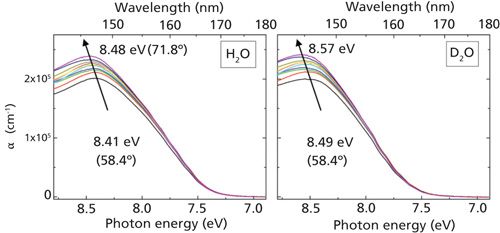
Figure 3: FUV absorption spectra of H2O (left) and D2O (right) with various incident angles shown in parentheses. (Adapted with permission from reference 24.)
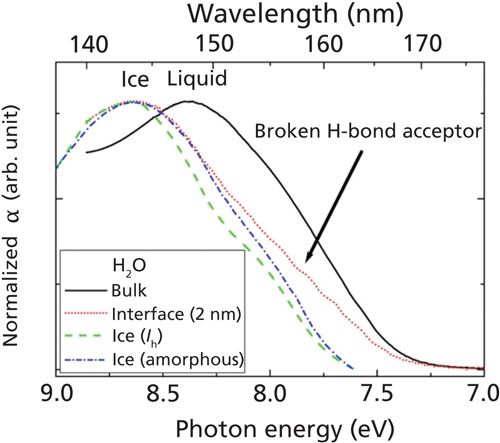
Figure 4: Normalized Ã<X~ bands of bulk and interfacial H2O in the liquid state determined by the present experiment and those of Ih and amorphous ice states obtained from reference 70. (Adapted with permission from from reference 26.)
Alkanes
We obtained FUV spectra of organic molecules in the condensed phase such as alcohols (11), n-alkanes and branched alkanes (15), ketones (13), and amides (16) to investigate their characteristic bands, band assignments, and electronic structure and transitions. Figures 5a and 5b depict ATR-FUV spectra of n-alkanes (CmH2m+2, m = 5–9) in the region of 8.5–6.5 ev (140–300 nm) and their calculated spectra in the region 9.5–6.5 eV (130–190 nm) by time-dependent density functional theory (TD-DFT)/aug-cc-pVTZ (15). The FUV spectra of n-alkanes (Figure 5a) yield a broad feature near 150 nm. This band shows a lower energy shift and significant intensity increase as the alkyl chain length increases. Quantum chemical calculations revealed that the band around 150 nm for n-alkanes was due to the σ-Rydberg 3py transition, and its red shift was caused by the destabilization of the σ orbital and the stabilization of the Rydberg 3p level, which is enhanced as the carbon chain increases (15). The calculated spectra are in good agreement with the observed FUV spectra in terms of the redshift of the main peak with a significant increase in intensity corresponding to increased alkyl chain length, although the calculations overestimate the peak positions by about 0.5 eV. According to calculations, the most intense peak is attributed to the transition from HOMO-2(σ) to Rydberg 3py (hereafter denoted as T1) (15). All n-alkanes investigated have similar transition natures to that of T1, although the energy level of HOMO-2(σ) interchanges with HOMO-3(π) at m = 7 (n-heptane). A transition from HOMO-1(π) to Rydberg 3py is the second most intense transition (T2), while other transitions, namely π-Rydberg 3px and σ-Rydberg 3px, also contribute to this broad band.

Figure 5: (a) ATR-FUV spectra and (b) calculated FUV spectra of n-alkanes (CmH2m+2, m = 5–9). (Adapted with permission from reference 15.)
Basic and Practical Applications of FUV Spectroscopy
FUV spectroscopy has recently been employed for both basic and practical applications (2–5):
- Quantitative and qualitative analyses of water and aqueous solutions including mineral water, spring water, and wastewater (12,14,20).
- On-line analysis such as monitoring semiconductor water-cleaning solutions and disinfectant solutions (7).
- Polymer thin film analysis (9).
- Monitoring of radical species in semiconductor water-cleaning solutions (20).
- Measuring physical properties of semiconductor materials such as TiO2 (21–23,25).
- SPR in the FUV region.
In the following section we outline three examples, namely polymer thin film analysis (9), direct measurement of peracetic acid, hydrogen peroxide, and acetic acid in disinfectant solutions (7), and studies of the electronic state and photocatalytic activity of TiO2.
Polymer Films
Figure 6 shows spectra in the 150–450 nm region of polyethylene (PE), polypropylene (PP), polyvinyl chloride (PVC), polystyrene (PS), and polyethylene terephthalate (PET) ï¬lms measured with a commercial FUV spectrometer (KV-201, Bunkoh Keiki Co., Ltd.) (2). Figure 7 compares spectra in the region of 120–300 nm of commercial food warp ï¬lms. The ï¬lm thickness was about 10 μm for all the samples (9). It is noted that FUV–DUV–near–UV (NUV) spectroscopy is powerful in discriminating polymer films. Sato and colleagues (9) investigated the potential of FUV-DUV spectroscopy in the region of 120-300 nm in polymer film analysis. In particular, they attempted to classify commercial food wrap films (three types of PE, polyvinylidene chloride (PVDC), and PVC using FUV–DUV spectroscopy (9). The spectra of three kinds of PE films (samples 4, 5, and 6), the PVC film (sample 3), and the two kinds of PVDC films (samples 1 and 2) contained spectral features that were clearly different from each other (Figure 7). The PE films show a broad band below 170 nm arising from the σ–σ* transition of C-C bonds in PE, and a weak feature near 185 nm seems to come from small alkyl branches of the PEs, as will be discussed below.
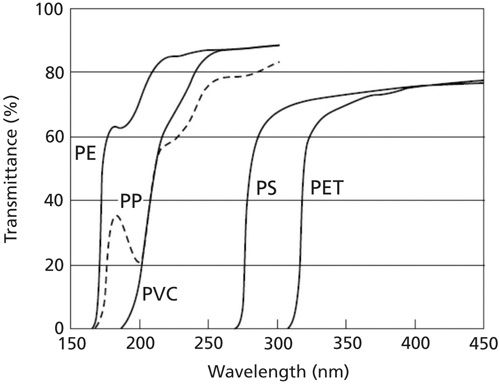
Figure 6: FUV-DUV spectra in the 150–450 nm region of polyethylene (PE), polypropylene (PP), polyvinyl chloride (PVC), polystyrene (PS), and polyethylene terephthalate (PET) films measured with a commercial FUV spectrometer (KV-201, Bunkoh-Keiki Co., Ltd.). (Adapted with permission from reference 9.)
A σ–σ* transition is due to the transition from a bonding orbital to an antibonding orbital, and has energy nearly equal to double the bonding energy. Ethane has a band at 135 nm assigned to the C–C bond σ–σ* transition. The absorption maxima of σ–σ* transition bands in PE films should be located below 165 nm, although they are not clear in Figure 7 (9). PVC and PVDC showed the corresponding transitions at a longer wavelength because the presence of C-Cl bonds affects the σ–σ* transitions of C–C bonds. PVC and PVDC had one and two C–Cl bonds in the polymer units, respectively, and thus the PVDC band had the longest wavelength (9).
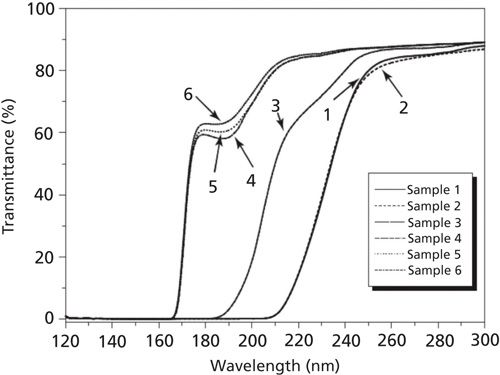
Figure 7: FUV spectra in the 120–300 nm region of polyvinylidene chloride (PVDC) films with different additives (samples 1 and 2), one polyvinyl chloride (PVC) film (sample 3), and polyethylene (PE) films from three sources (samples 4, 5, and 6). (Adapted with permission from reference 9.)
Spectra in the 120–300 nm region of pristine polymer films of three kinds of PE (high-density PE, [HDPE] low-density PE [LDPE], and n- low-density PE [LLDPE]) and PVC, are compared in Figures 8a and 8b, respectively (9). The intensity of the absorption band near 185 nm is largely different among the three kinds of PE films. LDPE, which has large side chains compared with HDPE and LLDPE, has a significantly stronger band near 185 nm. Thus, it is very likely the band near 185 nm arises from branches of the PEs.
The bonding energy of a C–C bond changes with substituents on the C atoms, and thus the σ–σ* transition is very sensitive to substituents. Thus, the FUV–DUV spectra of substituted hydrocarbon compounds varied with the type and number of substituents. Consequently, FUV-DUV spectroscopy holds considerable promise as a qualitative analysis method for polymers (9).
TiO2 and Metal-Modified TiO2
Figure 9a shows an FUV–DUV spectrum of anatase TiO2 nanoparticles (22). The spectrum has three weak features at ~160, 200, and 260 nm (36). Spectra obtained by Sério and colleagues using synchrotron radiation spectroscopy also showed very weak and broad absorption bands at ~200 and 260 nm (36). They assigned these two bands to the eg(σ) → t2g(ππ*) and t2g(π) → t2g(π*) transitions, respectively, based on molecular orbital energy level diagrams and calculated band structures reported by other groups (37,38). Based on these previously reported experimental and theoretical results, Tanabe and colleagues (22) assigned the band at ~160 nm in Figure 8 to the t2g() → eg(σ*) transition, as shown in the inset in Figure 9a. The spectra of TiO2 nanoparticles can be measuredmuch more easily by the ATR-FUV–DUV spectrometer than a spectrometer with synchrotron radiation.

Figure 8: (a) FUV spectra in the 120–300 nm region of three kinds of polyethylenes (high-density polyethylene [HDPE], low-density polyethylene [LDPE], and linear low-density polyethylene [LLDPE]). (b) FUV spectrum of PVC. (Adapted with permission from reference 9.)
Tanabe and colleagues (21) compared FUVDUV spectra of TiO2 and TiO2 with metal (Au, Pd, and Pt) nanoparticles measured under conditions that the metal nanoparticle diameter was several nanometres and the amount of deposited metal nanoparticles was ~0.04 wt%. Figure 9b depicts FUV-DUV spectra of TiO2 and TiO2 with metal (Au, Pd, and Pt) nanoparticles (21). It can be seen that upon the deposition of metal nanoparticles, spectral intensity in the longer wavelength region (approximately 270–300 nm) became weak while that in the shorter wavelength region (approximately 150–180 nm) became strong (21). Moreover, the degree of spectral change strongly depended on the type of metal nanoparticle used. Pt nanoparticles brought about the largest change in spectral intensity, while Au nanoparticles had little effect. The work functions of TiO2, Au, Pd, and Pt are 4.0, 4.7, 4.9, and 5.7 eV, respectively. It is very likely that a larger work function in modifying metals results in larger FUV–DUV spectral changes.
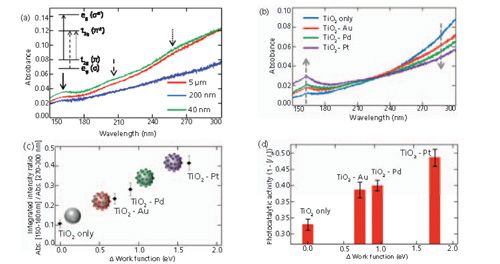
Figure 9: (a) Typical FUV-DUV spectra of TiO2 nanoparticles (adapted with permission from reference 22). (b) FUV–DUV spectra of TiO2 only (blue) and TiO2 with Au (red), Pd (green), and Pt (purple) nanoparticles (adapted with permission from reference 21). (c) Integrated intensity ratio of the 150–180 nm region and the 270–300 nm region plotted versus the difference in the work function between TiO2 and each metal (adapted with permission from reference 21). (d) Photocatalytic activity of each material (adapted with permission from reference 21).
To explore the origin of these spectral variations, Tanabe and colleagues (21) calculated the integrated intensity ratio of spectral intensity in the longer wavelength region (270–300 nm) to that of the shorter wavelength region (150–180 nm). These ratios are plotted against the difference in the work function between TiO2 and each metal in Figure 9c (21). The plot demonstrates a strong positive correlation between intensity ratio and work function.
They disclosed the origin of the spectral variations was caused by metal nanoparticle deposition. Contact of TiO2 with a metal having a higher work function than its own brings about electron flow into the said metal, until both Fermi levels become equal, resulting in the decrease in the number of electrons at relatively high energy levels in TiO2, which can be excited by relatively long wavelength light. Such electron transfers cause suppression of the absorption intensity in the longer wavelength region. However, as noted above, by depositing metal nanoparticles on TiO2, the nanoparticles work as an electron sink for photo-excited electrons, and the charge-separation efficiency of TiO2 is enhanced. This enhancement of charge-separation efficiency means that more electrons can be excited and more UV light can be absorbed, leading to an increase in spectral intensity in the shorter wavelength region. This process may also occur in the longer wavelength region, but the overall change in spectral intensity is affected both by this enhancement and the decrease in the number of electrons. The positive relationship between the degree of spectral changes and the work function of metals (Figure 9b) indicates that the larger work function difference between TiO2 and metal results in increased electron inflow from TiO2 to the metal, and thus, a larger enhancement of the charge separation.
These electronic state changes should affect the photocatalytic activity. Actually, the photocatalytic activity of each sample strongly depended on the work function of the modified metal, as shown in Figure 9d (21). The photocatalytic activity is estimated based on the photodegradation reaction of methylene blue, 1 â I/I0, where I0 and I are the absorbance of methylene blue aqueous solution at 665 nm before and after UV light irradiation, respectively(21). It should be noted that there was also a strong positive correlation in Figure 9c, as seen in the case of Figure 9b. These results indicate that larger electron transfer and charge separation enhancement lead to higher photocatalytic activity.
The photocatalytic activity of TiO2 modified with metal nanoparticles is affected not only by the kind of modified metal, but also by the metal sizes and shapes (23). The FUV–DUV spectra of TiO2 modified with metal nanoparticles also reflect the differences in size and shape of the metal nanoparticles.
Direct Measurement of Peracetic Acid, Hydrogen Peroxide, and Acetic Acid in Disinfectant Solutions
The direct determination of peracetic acid, hydrogen peroxide (H2O2), and acetic acid in disinfectant solutions was carried out by using theier absorption bands in the 180–220 nm region (7). The FUV method we proposed does not require any reagents or catalysts, a calibration standard, and a complicated procedure for the analysis.
A peracetic acid solution is prepared from acetic acid and hydrogen peroxide in the presence of an acidic catalyst, usually H2SO4 (7). The equilibrium state is described by following equation:

Thus, industrial peracetic acid solutions always contain significant amounts of H2O2. The analysis method for peracetic acid requires high selectivity and less cross-reaction with H2O2 and acetic acid in their coexistence. We reported the usefulness of FUV absorption spectroscopy for direct determination of three species: peracetic acid, H2O2 and acetic acid in their coexistent solutions.
Figure 10a depicts FUV absorption spectra obtained using a commercial spectrometer (Shimadzu UV-2550 UV–visible spectrophotometer) and a cuvette cell of pathlength 10 mm of an aqueous solution of acetic acid with concentration of 1.7 wt%, an aqueous solution of H2O2 with concentration of 0.2 wt%, and a peracetic acid disinfectant solution with concentrations of 0.86, 0.23 and 0.22 wt% of peracetic acid, H2O2 and acetic acid, respectively (7). Figure 10a and the second derivative spectra shown in Figure 10b show that these spectra can be used for the measurement of each solute in the coexistence of their species (7). The detection limit for peracetic acid of the new FUV spectrometer was evaluated to be 0.002 wt%, and the dynamic ranges of the measured concentrations were from 0 to 0.05 wt%, from 0 to 0.2 wt%, and from 0 to 0.2wt% for peracetic acid, H2O2, and acetic acid, respectively (7).
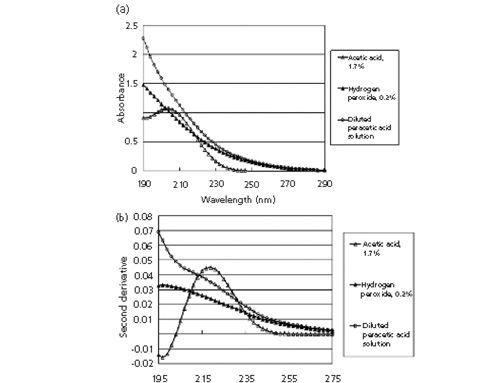
Figure 10: (a) FUV–DUV absorption spectra of an aqueous solution of acetic acid with a concentration of 1.7 wt%, an aqueous solution of hydrogen peroxide with a concentration of 0.2 wt%, and diluted peracetic acid disinfectant solution (AKTIVE90) with concentrations of 0.86, 0.23, and 0.22 wt% for peracetic acid, hydrogen peroxide, and acetic acid, respectively. (b) Second derivative spectra of FUV–DUV absorption spectra shown in (a). (Adapted with permission from reference 7.)
The difference in the measurable shortest wavelength limit between this spectrometer and commercial UV–vis spectrometers is only 10 nm (180 nm versus 190 nm), but this small difference makes a huge difference in sensitivity for aqueous solutions because, in general, absorbance at 180 nm of an aqueous solution is much greater than that at 190 nm.
Water and aqueous solutions have very steep tails in the 170–200 nm region. This tail is useful in the quantitative analysis of aqueous solutions (2,3). For industrial applications, subsequent development of compact FUV–DUV spectrometers is indicated.
Future Prospects
As described above, ATR-FUV spectroscopy has brought a new era of FUV spectroscopy (3). Previously, it was difficult to observe the electronic transitions of solid and liquid samples in the FUV region, but situation has been changed dramatically by the introduction of ATR-FUV spectroscopy. It has provided novel information about transitions involving σ electrons, transitions and Rydberg transition. A variety of molecules, such as alcohols, ketones, amides, and nylons, have been shown to have Rydberg transitions in the 140–200 nm region. FUV spectroscopy has been used for a variety of novel applications, including investigations of electronic states in TiO2 and related materials, water research, in terms of both basic science and practical applications, monitoring radicals in aqueous solutions by time-resolved FUV–DUV spectroscopy, on-line analysis, and polymer film analysis.
FUV spectroscopy holds considerable promise as a new electronic spectroscopy technique for condensed materials. From the point of basic spectroscopy, the following points are noted:
- A further development of quantum chemical calculations in FUV–DUV spectroscopy is of particular importance for providing further insights into electronic transitions and structure of condensed materials.
- Time-resolved FUV spectroscopy is promising for exploring photochemical reactions in the FUV region.
- ATR-FUV spectroscopy is useful for investigating a surface of ultrathin films and adsorption on a surface from the point of both basic studies and applications.
Spectral measurement of the whole FUV–DUV–NUV region (140–400 nm) can be easily carried out. We recently measured the FUV–DUV–NUV spectra of polymer nanocomposites containing graphene and carbon nanocube. Polymers show bands in the FUV region, and carbon materials yield bands in the DUV–NUV region. Thus, by measuring the entire region, we can explore electronic structures of both polymers and carbon materials simultaneously under the same experimental conditions.
From the perspective of practical applications, the following points are noteworthy:
- Development of compact FUV–DUV spectrometers for online and inline analysis. Even an instrument suitable for a narrow wavelength region such as the so-called tail region (170–200 nm) is often sufficient for these applications.
- As new application areas, geochemical and environmental technology may be worth noting.
- Development of FUV–DUV SPR sensors may receive keen interest because they have higher sensitivity than visible SPR sensors, and the former has clear surface selectivity and material selectivity.
Acknowledgments
The author thanks his coworkers in the studies reported in this review, particularly (chronological order) Dr. N. Higashi (Kurabo Industrials Ltd.), Dr. A. Ikehata (National Food Research Institute), Prof. H. Sato (Kobe University), Prof. Y. Morisawa (Kinki University), Mr. S. Tachibana (Kurabo Industries Ltd.), Prof. M. Ehara (Institute for Molecular Science), and Dr. T. Goto (Kwansei Gakuin University).
References
- P.E. Hockberger, Photochem. Photobio.76, 561–579 A (2002).
- Y. Ozaki, Y. Morisawa, A. Ikehata, and N. Higashi, Appl. Spectrosc.66, 1 (2012).
- Y. Ozaki and S. Kawata, Far- and Deep Ultraviolet Spectroscopy (Springer Japan, 2015).
- Y. Morisawa, T. Goto, A. Ikehata, N. Higashi, and Y. Ozaki, Encyclopedia of Analytical Chemistry (J. Wiley & Sons, Hoboken, New Jersey, 2013), p. 1. DOI: 10.1002/9780x70027318.a9279
- Y. Ozaki and I. Tanabe, Analyst, in press.
- N. Higashi and Y. Ozaki, Appl. Spectrosc.58, 910 (2004).
- N. Higashi, H. Yokota, S. Hiraki, and Y. Ozaki, Anal. Chem.77, 2272 (2005).
- N. Higashi, A. Ikehata, and Y. Ozaki, Rev. Sci. Instrum.78, 103107 (2007).
- H. Sato, N. Higashi, A. Ikehata, and Y. Ozaki, Appl. Spectrosc.61, 780 (2007).
- A. Ikehata, Y. Ozaki and N. Higashi, J. Chem. Phys.129, 234510 (2008).
- Y. Morisawa, A. Ikehata, N. Higashi, and Y. Ozaki, Chem. Phys. Lett., 476, 205 (2009).
- A. Ikehata, M. Mitsuoka, Y. Morisawa, N. Kariyama, N. Higashi, and Y. Ozaki, J. Phys. Chem.114, 8319 (2010).
- Y. Morisawa, A. Ikehata, N. Higashi, and Y. Ozaki, J. Phys. Chem.115, 562 (2011).
- M. Mitsuoka, H. Shinzawa, Y. Morisawa, N. Kariyama, N. Higashi, M. Tsuboi, and Y. Ozaki, Anal. Sci.27, 177 (2011).
- Y. Morisawa, S. Tachibana, M. Ehara, and Y. Ozaki, J. Phys. Chem.116, 11957 (2012).
- Y. Morisawa, M. Yasunaga, R. Fukuda, M. Ehara, and Y. Ozaki, J. Chem. Phys, 139, 154301 (2013).
- T. Goto, A. Ikehata, Y. Morisawa, N. Higashi, and Y. Ozaki, Phys. Chem. Chem. Phys14, 8097 (2014).
- T. Goto, A. Ikehata, Y. Morisawa, N. Higashi, and Y. Ozaki, Inorg. Chem.51, 10650 (2012).
- Y. Morisawa, N. Higashi, K. Takaba, N. Kariyama, T. Goto, A. Ikehata, and Y. Ozaki, Rev. Sci. Instrum.83, 073103 (2012).
- T. Goto, Y. Morisawa, N. Higashi, A. Ikehata, and Y. Ozaki, Anal. Chem.85, 4500 (2013).
- I. Tanabe, and Y. Ozaki, Chem. Commun.50, 2117 (2014).
- I. Tanabe, T. Ryoki, and Y. Ozaki, Phys. Chem. Chem. Phys16, 7749 (2014).
- I. Tanabe, T. Ryoki, and Y. Ozaki, RSC Adv.5, 13678 (2015).
- T. Goto, A. Ikehata, Y. Morisawa, and Y. Ozaki, J. Phys. Chem. Lett.6, 1022 (2015).
- I. Tanabe, Y. Yamada, and Y. Ozaki, Chem-PhysChem.17, 516 (2016).
- M.B. Robin, Higher Excited States of Polyatomic Molecules: Vol. II (Academic Press Inc., New York, New York., 1974).
- M.B. Robin, Higher Excited States of Polyatomic Molecules: Vol. III (Academic Press Inc., Orlando, Florida, 1985), p176.
- N. Damany, J. Romand, and B. Vodar, Eds., Some Aspects of Vacuum Ultraviolet Radiation Physcis (Pergamon Press, Oxford, 1974).
- C. Sándorfy, Ed., The Role of Rydberg States in Spectroscopy and Photochemistry-Low and High Rydberg States (Kluwer Academic Publishers, Dordrecht, 1999).
- G. W. Rubloff, H. Fritzsche, U. Gerhardt, and J. Freeouf, Rev. Sci. Instrum.42, 1507 (1971).
- J. M. Jung and H. Gress, Chem. Phys. Lett.359, 153 (2002).
- K. Weiss, P. S. Baguo and Ch. Wöll, J. Chem. Phys.111, 6834 (1999).
- E.A. Costner, B. K. Long, C. Navar, S. Jockusch, X. Lei, P. Zimmerman, A. Campion, N. J. Turro, and C.G. Willson, J. Phys. Chem. A113, 9337 (2009).
- L.R. Painter, R.D. Birkhoff, and E.T. Arakawa, J. Chem. Phys.51, 243 (1969).
- G.D. Kerr, J.T. Cox, L.R. Painter, and R.D. Birkhoff, Rev. Sci. Instrum.42, 1418 (1971).
- S. Sério, M.E. Melo Jorge, M.L. Coutinho, S.V. Hoffman, P. Limão-Vieria, and Y. Nunes, Chem. Phys. Lett.508, 71 (2011).
- N. Hosaka, T. Sekiya, C. Satoko, and S. Kurita, J. Phys. Soc. Japan66, 877 (1997).
- R. Asahi, Y. Taga, W. Mannstadt, and A.J. Freeman, Phys. Rev. B61, 7459 (2000).
Yukihiro Ozaki is with the School of Science and Technology at Kwansei Gakuin University in Sanda, Japan. Direct correspondence to ozaki@kwansei.ac.jp
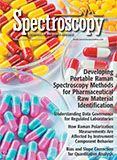
Geographical Traceability of Millet by Mid-Infrared Spectroscopy and Feature Extraction
February 13th 2025The study developed an effective mid-infrared spectroscopic identification model, combining principal component analysis (PCA) and support vector machine (SVM), to accurately determine the geographical origin of five types of millet with a recognition accuracy of up to 99.2% for the training set and 98.3% for the prediction set.
Authenticity Identification of Panax notoginseng by Terahertz Spectroscopy Combined with LS-SVM
In this article, it is explored whether THz-TDS combined with LS-SVM can be used to effectively identify the authenticity of Panax notoginseng, a traditional Chinese medicine.